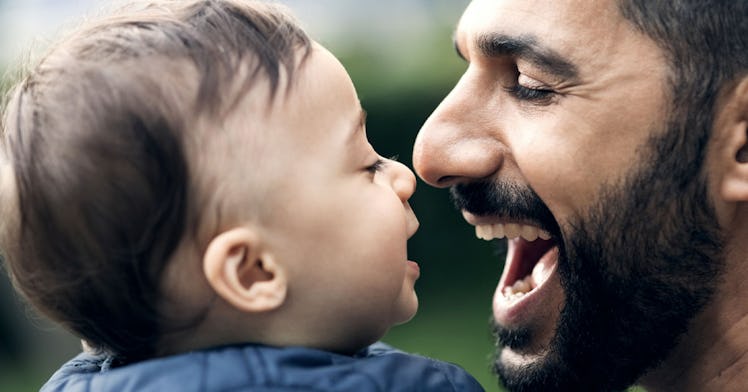When Do Babies Understand Facial Expressions?
Depends on the expression, but they do know if you're happy.

Everyone smiles at newborns, but newborns don’t necessarily understand what those smiles mean. Ditto with toddlers and the more complex facial expressions (and weird faces) people toss their way. Though studies suggest that humans learn to differentiate between happy, sad, and angry expressions relatively early on, there’s a learning curve when it comes to mastering more subtle facial expressions, like surprise, fear, and disgust. Here’s what we know about when and how babies, children, and teenagers learn to recognize facial expressions.
Newborns: Good With Faces, Bad With Feelings
From the moment a baby is born, they are looking for faces. Studies have shown that even nine-minute-old babies prefer to look at clear images of faces rather than scrambled images. Hours later, studies suggest that babies can differentiate between their mother’s face and that of a strange woman, and that they stare longer at images of their mothers than other images.
But when it comes to recognizing facial expressions, the research is far less settled. Charles Darwin wrote about it in the late 1800s, and modern scientists have been debating it ever since. In 2007, researchers tested 17 healthy newborns within the first 24 hours of life and found that they were entirely unable to discriminate or even show preference for scared versus neutral faces—but they did spend more time staring at happy faces. This indicates that “at least some expressions are discriminated and preferred in newborns only a few days old,” according to researchers.
After that, baby’s emotional intelligence skyrockets. A large 1982 study in Science found that five-month-olds can match a sad face to a sad voice, and a 2008 study found that one-year-olds take social cues from facial expressions—if their mothers give discouraging expressions, they stop crawling down a potentially dangerous slope. If their mothers smile, they trek onwards. Reactions to facial expressions only improve as a baby ages. One study of toddlers found that they avoid approaching new toys unless their mothers smile at them encouragingly.
Kids And Teens: Learning Surprise, Fear, and Disgust
Research on when children and adolescents grow to understand the full range of facial expressions is a mixed bag. One 2004 literature review threw up its hands and concluded that: “Methodological inconsistencies and disparate findings make any conclusion difficult.”
But in 2015 researchers surveyed 478 children and adolescents in the UK, and presented perhaps the first robust study to track how our understanding of facial expressions develops over time. They showed each child 60 pictures of faces expressing one of these six emotions:
Each time a child saw a face, they clicked on the word “happy, sad, angry, fearful, disgusted, or surprised” to describe what the person in the picture was likely feeling. At all ages, children pretty much nailed the “happy, sad, angry” faces. But, until age 8, few children detected “surprise” accurately. They were unable to detect “disgust” until age 14, or “fearful” until age 16.
It’s unclear why it takes more time for kids to learn to identify surprise, disgust, and fear than “primary color” emotions like joy and sadness. It is possible that it has to do with information being conveyed by different parts of the face, but we have no reason to believe that children are better or worse at detecting changes in, for instance, the eyes versus the mouth. One 2013 study suggests that young children may divide faces into two categories—”feels good” and “feels bad”—but have difficulty working with faces that don’t clearly fit into either box, such as “surprised” or “fearful.”
And then there’s puberty. As adolescents approach puberty, they become obsessed with social acceptance and more sensitive to how others evaluate them. It’s a time when facial expressions mean everything—and preliminary evidence suggests adolescent brains may alter to meet those demands.
“The synaptic reorganization that is evident in the adolescent brain may make regions dedicated to processing emotional information especially sensitive to environmental experience during this period of development,” the authors of the 2015 study write. “It might be hypothesized that hormonal changes during puberty differentially affect psychological processes and potentially neural circuits involved in the recognition of these facial expressions.”
When Not Recognizing Facial Expressions Is A Problem
Scientists generally agree that, by the time an adolescent reaches age 16, they should be fairly comfortable identifying facial expressions across the emotional spectrum. But in some cases, this skill never develops properly. Children with autism, for instance, tend to be less accurate at reading all facial expressions—even the most basic “happy, sad, angry” ones.
There are several broad terms that describe people who cannot read emotions on their peers’ faces—emotional agnosia (inability to perceive facial expressions), prosopagnosia (face blindness), alexithymia (inability to describe or identify emotions)—but most of these conditions are symptoms of more complex psychological disorders. Brain damage can also play a role.
But if your child can’t tell when you’re surprised or disgusted, they are probably perfectly healthy. However frustrating it may be that your kids can’t tell that you’re frustrated by looking at you—living in blissful ignorance of dad’s facial expressions is usually just part of growing up.
This article was originally published on